Related Research Articles
George Jackson Churchward was an English railway engineer, and was chief mechanical engineer of the Great Western Railway (GWR) in the United Kingdom from 1902 to 1922.

The first Locomotives of the Great Western Railway (GWR) were specified by Isambard Kingdom Brunel but Daniel Gooch was soon appointed as the railway's Locomotive Superintendent. He designed several different 7 ft 1⁄4 in broad gauge types for the growing railway, such as the Firefly and later Iron Duke Class 2-2-2s. In 1864 Gooch was succeeded by Joseph Armstrong who brought his standard gauge experience to the workshops at Swindon. To replace some of the earlier locomotives, he put broad gauge wheels on his standard gauge locomotives and from this time on all locomotives were given numbers, including the broad gauge ones that had previously carried just names.

The Great Western Railway 3200 Class was a design of 4-4-0 steam locomotive for passenger train work. The nickname for this class, almost universally used at the time these engines were in service was Dukedog since the locomotives were composed of former Duke Class boilers on Bulldog Class frames. As such they were one of the last standard gauge steam locomotive classes to retain outside frames.

The Great Western Railway 4900 Class or Hall Class is a class of 4-6-0 mixed-traffic steam locomotives designed by Charles Collett for the Great Western Railway. A total of 259 were built at Swindon Works, numbered 4900–4999, 5900–5999 and 6900–6958. The LMS Stanier Class 5 4-6-0 and LNER Thompson Class B1 both drew heavily on design features of the Hall Class. After nationalisation in 1948, British Railways gave them the power classification 5MT.

5972 Olton Hall is a preserved Great Western Railway Hall class locomotive made famous for being depicted to pull the Hogwarts Express in the Harry Potter film series.
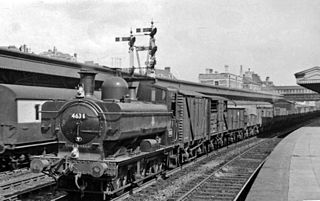
The GWR 5700 Class, or 57xx class, is a class of 0-6-0 pannier tank steam locomotive built by the Great Western Railway (GWR) and British Railways (BR) between 1929 and 1950. With 863 built, they were the most prolific class of the GWR, and one of the most numerous classes of British steam locomotive.

The Great Central Railway (GCR) Class 8K 2-8-0 is a class of steam locomotive designed for heavy freight. Introduced in 1911, and designed by John G. Robinson, 126 were built for the GCR prior to the First World War. Including wartime construction for the British Army ROD and the post-war GCR Class 8M, the class and its derivatives totalled 666 locomotives.
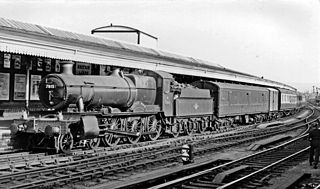
The Great Western Railway (GWR) 7800 Class or Manor Class is a class of 4-6-0 steam locomotive. They were designed as a lighter version of the Grange Class, giving them a wider Route Availability. Like the 'Granges', the 'Manors' used parts from the GWR 4300 Class Moguls but just on the first batch of twenty. Twenty were built between 1938 and 1939, with British Railways adding a further 10 in 1950. They were named after Manors in the area covered by the Great Western Railway. Nine are preserved.

The Great Western Railway (GWR) 6800 Class or Grange Class was a mixed-traffic class of 4-6-0 steam locomotive, built to replace the GWR 4300 Class 2-6-0. There were 80 in the class, all built at the Swindon works, using some reconditioned parts from withdrawn 4300 Class locomotives.

The Great Western Railway (GWR) 6959 or Modified Hall Class is a class of 4-6-0 steam locomotive. They were a development by Frederick Hawksworth of Charles Collett's earlier Hall Class named after English and Welsh country houses.

The Great Western Railway (GWR) 1600 Class is a class of 0-6-0 pannier tank steam locomotive designed for light branch lines, short-distance freight transfers and shunting duties.

The Great Western Railway (GWR) 9400 Class is a class of 0-6-0 pannier tank steam locomotive, used for shunting and banking duties.
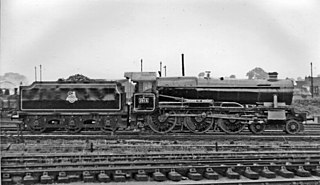
The Great Western Railway 1000 Class or County Class was a class of 4-6-0 steam locomotive. Thirty examples were built between 1945 and 1947, but all were withdrawn and scrapped in the early 1960s. A replica locomotive is under construction.

The Great Western Railway (GWR) 1366 Class is a class of 0-6-0 pannier tank steam locomotives built in 1934. They were a useful design and because of their light weight and short wheelbase and were often used on dockside branches or other lines with sharp curvatures.

The Great Western Railway (GWR) 4300 Class is a class of 2-6-0 (mogul) steam locomotives, designed by G.J. Churchward for mixed traffic duties. 342 were built from 1911–1932.

The Great Western Railway (GWR) 5400 Class was a class of 0-6-0 pannier tank steam locomotive. They were similar in appearance to many other GWR tank engines but smaller than the ubiquitous GWR 5700 Class.
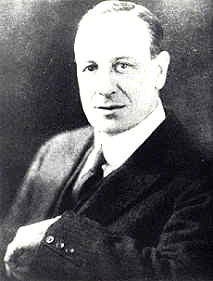
Charles Benjamin Collett was Chief Mechanical Engineer of the Great Western Railway from 1922 to 1941. He designed the GWR's 4-6-0 Castle and King Class express passenger locomotives.

Frederick William Hawksworth, was the last Chief Mechanical Engineer of the Great Western Railway (GWR).
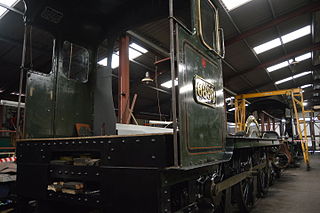
No.6880 Betton Grange is a steam locomotive which is under construction as a "new-build" project, originally based on the Llangollen Railway in Denbighshire, Wales, then subsequently at Tyseley Locomotive Works. Described as "building the 81st Grange", the project started in 1998, and the locomotive was earlier expected to be operational by 2013, but subsequently by Autumn 2021. All of the original GWR 6800 Class Grange locomotives were withdrawn for scrap by the end of 1965; this project is a creation, from an assemblage of original GWR and newly manufactured components, of a member of this class.
Barry Railway Class A were the first steam tank engines to be built for the Barry Railway in South Wales and had an 0-6-0T wheel arrangement. They were designed by John Wolfe Barry and built by Sharp Stewart.
References
- Daniel, John. "GWR Hall class". Great Western Archive. Retrieved 17 October 2009.
- Whitehurst, Brian (1973). Great Western Engines, Names, Numbers, Types and Classes (1940 to Preservation). Oxford, UK: Oxford Publishing Company. pp. 63, 69. ISBN 978-0-9028-8821-0. OCLC 815661.